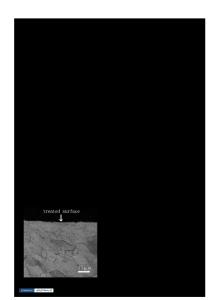Effect of Process Parameters on Defects, Melt Pool Shape, Microstructure, and Tensile Behavior of 316L Stainless Steel P
- PDF / 7,025,342 Bytes
- 16 Pages / 595.276 x 790.866 pts Page_size
- 110 Downloads / 397 Views
Effect of Process Parameters on Defects, Melt Pool Shape, Microstructure, and Tensile Behavior of 316L Stainless Steel Produced by Selective Laser Melting Hua‑Zhen Jiang1,2 · Zheng‑Yang Li2 · Tao Feng3 · Peng‑Yue Wu3 · Qi‑Sheng Chen1,2 · Yun‑Long Feng3 · Long‑Fei Chen3 · Jing‑Yu Hou1,2 · He‑Jian Xu2 Received: 25 February 2020 / Revised: 2 August 2020 / Accepted: 3 August 2020 © The Chinese Society for Metals (CSM) and Springer-Verlag GmbH Germany, part of Springer Nature 2020
Abstract Previous studies have revealed that laser power and energy density are significant factors affecting the quality of parts manufactured by selective laser melting (SLM). The normalized equivalent density E0* and dimensionless laser power q*, which can be regarded as a progress on the understanding of the corresponding dimensional quantities, are adopted in this study to examine the defects, melt pool shape, and primary dendrite spacing of the SLM-manufactured 316L stainless steel, because it reflects the combined effect of process parameters and material features. It is found that the number of large defects decreases with increasing E0* due to enough heat input during the SLM process, but it will show an increasing trend when excessive heat input (i.e., utilizing a high E0*) is imported into the powder bed. The q* plays an important role in controlling maximum temperature rising in the SLM process, and in turn, it affects the number of large defects. A large q* value results in a low value of absolute frequency of large defects, whereas a maximum value of absolute frequency of large defects is achieved at a low q* even if E0* is very high. The density of the built parts is greater at a higher q* when E0* remains constant. Increasing the melt pool depth at relatively low value of E0* enhances the relative density of the parts. A narrow, deep melt pool can be easily generated at a high q* when E0* is sufficiently high, but it may increase melt pool instability and cause keyhole defects. It is revealed that a low E0* can lead to a high cooling rate, which results in a refined primary dendrite spacing. Relatively low E0* is emphasized in selecting the process parameters for the tensile test sample fabrication. It shows that excellent tensile properties, namely ultimate tensile strength, yield strength, and elongation to failure of 773 MPa, 584 MPa, and 46%, respectively, can be achieved at a relatively low E0* without heat treatment. Keywords Selective laser melting · Defects · Melt pool shape · Primary dendrite spacing · Mechanical properties · 316L stainless steel Electronic supplementary material The online version of this article (https://doi.org/10.1007/s40195-020-01143-8) contains supplementary material, which is available to authorized users. Available online at https://link.springer.com/journal/40195. * Zheng‑Yang Li [email protected] * Qi‑Sheng Chen [email protected] 1
School of Engineering Science, University of Chinese Academy of Sciences, Beijing 100190, China
2
Institute of Mechanics, Chinese Academy of Sci
Data Loading...










